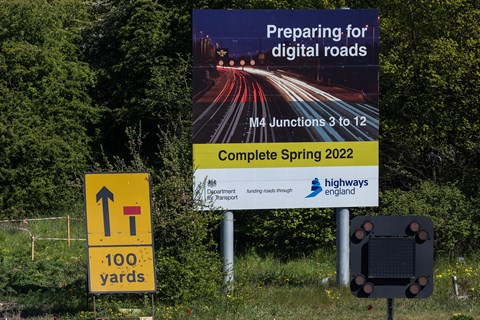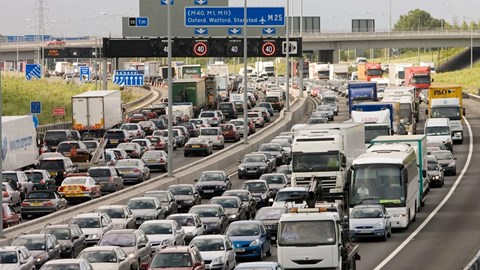► Smart motorways riddled with errors
► Powercuts, broken radar, tech gremlins galore
► Why smart motorways are being cancelled
Britain’s smart motorway network is riddled with technical errors, a BBC Panorama investigation has found – casting further doubt on the supposedly dynamic, high-tech type of modern road.
Investigators for the programme uncovered hundreds of incidents when the technology underpinning 193 miles of smart motorways failed, including:
- 397 powercuts between June 2022 and February 2024
- Five days of no signs, signals, camera or radar on the M6 junction 18
- No signs, signals or CCTV for five days on the M62 at junction 22
- No sensors working, signs or CCTV on the M5 at junction 6
Panorama claims that the technology is so unreliable that there were almost one power outage a day in the six months leading up to February 2024. National Highways insists that smart motorways are safe and claims that it has well established back-up plans to deal with powercuts and other system failures.

At least 79 people have been killed on smart motorways since their introduction in 2010, causing widespread criticism (see protest at 2022’s Conservative party conference in Birmingham, above). You can watch the Panorama programme Smart Motorways: When Technology Fails on the BBC iPlayer.
Smart motorways: the end of the road?
Plans for future smart motorway networks in the UK were officially cancelled last year. Prime Minister Rishi Sunak announced that any future development and construction plans for the controversial ‘upgrading’ of the UK’s motorway network was halted in April 2023.
This doesn’t mean that the current network of smart motorways in England will change per se, but it means the grand project will not be rolled out any further. The Government cites both safety concerns and ballooning costs of the projects as the main reasons for the cancellations.
In a statement on 15 April 2023, Sunak said: ‘Many people across the country rely on driving to get to work, to take their children to school and go about their daily lives and I want them to be able to do so with full confidence that the roads they drive on are safe.’
It’s quite the U-turn: smart motorways were once hailed the digital future of road transport (see below).

The cancellation follows a report published by a Transport select committee in early 2022, which demanded a number of safety measures be implemented, the Transport Secretary Grant Shapps announced a U-turn on the policy to roll out a further 120 miles of smart motorways and committed £390 million to deliver the committee’s suggested measures.
But what are smart motorways? Why the cause for controversy and are the concerns justified?
What are smart motorways?
From the get-go, smart motorways are confusing. The expression doesn’t refer to the whole motorway, but just to particular stretches of the M1, M3, M4, M5, M6, M20, M23, M25, M27, M40, M42, M56, M60 and M62 specifically. These ‘smart’ segments, identified as more heavily affected, operate sophisticated traffic management systems to better manage the volume and flow of traffic and peak times. This involves making use of the hard shoulder—the lane farthest left, indicated with a hard unbroken white lane—and the digital signage overhead, known as gantries.
What types of smart motorway are there?
There are three types of smart motorway:
1. All-lane running
‘All-lane running’ effectively deletes the hard shoulder. That particular stretch of road is considered so heavily congested, that the only way to move the volume of traffic using it, is to create a new lane, permanently. The gantries reduce the speed of all traffic to keep it flowing during peak periods. Cameras continuously monitor the roads for flow and incidents.
In the event of an accident, where the lane is required for emergency vehicles, a red ‘X’ appears on the overhead gantry and roadside displays indicate that all traffic in this lane must move right. Other lanes may be closed, so this can often lead to further disruption and delay, despite the overall objective being to maintain flow.
2. Dynamic hard shoulder
Dynamic hard shoulder versions of the smart motorway only use the hard shoulder when required. Like partially operating bus lanes, the hard shoulder is only engaged when the gantry says so, i.e. during peak periods of heavy congestion. Otherwise, it’s a hard shoulder.
3. Controlled motorway
As the law states, the speed for motorways is ‘National Speed Limit’ (currently 70mph), unless stated otherwise.
Controlled motorways utilise the variable speed limits to control traffic flow, but the rest of the route remains as it always has; three running lanes and a hard shoulder, which can only be used in a genuine emergency and for emergency vehicle access.

Why the cause for controversy?
The hard shoulder can often be abused by people having a quick wee, pulling over to make a phone call. Yet, in most cases, drivers pull left when they have broken down and there’s no alternative, such as an Emergency Refuge Area (ERA). If drivers sustain a crash, the law obliges both parties to stop and exchange an insurance details.
Often, the only opportunity to do this promptly is the hard shoulder. Records show that between 2015 and 2019, 39 people have died, either as a result of the lack of a hard shoulder, or by being on the hard shoulder when it was a live lane. Unsurprisingly, relatives of the deceased have campaigned heavily against the use of smart motorway schemes, specifically the two which involved utilising the hard shoulder. The news that any future smart motorway plans have been cancelled should come as good news, even if it doesn’t mean existing ones will be changed.
Deaths, while the primary issue, is not the only one. Should an incident occur, overhead gantries can change the speed at a moment’s notice. This creates confusion and concern amongst drivers who react by braking suddenly and severely, causing the opportunity for further accidents.
The drivers are simply reacting to speed cameras, in operation to ensure all vehicles are abiding by the updated limit. Yet, Highways England has admitted that there can be a lag between the cameras detecting a change and the signage updating appropriately, and a period of about 30 seconds between the speed updating and the contravention cameras coming into operation.
Are the concerns justified then?
Chairman of the Transport select, Huw Merriman, didn’t conceal the committee’s frustration at the wait to have these issues addressed, saying ‘This is the Committee’s second inquiry into Smart Motorways. Back in 2016, our concerns about safety were not addressed. Assurances were given and not delivered’.
While the report was rather scathing, saying the decision to ‘make all new motorways all-lane running was premature as the evidence base was insufficient’, the committee did welcome the government’s decision to act now. There’s a feeling that the smart motorways have been implemented a bit cart-before-the-horse, in that safety measures weren’t implemented ahead of their initial roll-out.
Such measures include providing emergency laybys. There were 400 emergency refuge areas required to make these sections of motorway safer. However, the plan to create 150, which fell short of the required 250, by 2024 has been abandoned. They need to be 0.75 miles apart and that target simply can’t be achieved.
What’s more, the committee also feels more information is needed before any further decisions are made. The government will ‘move to collect five years of safety and economic data for every all-lane running scheme introduced before 2020’. They have agreed to review these decisions on an annual basis, which by all accounts sounds like the smartest decision yet.